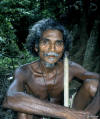|
|
The South
Asian Life & Times - SALT |
|
|||
|
Contents Adventure
Art
-
Dongria Kondh
|
|
||||
|
South Asia's Most Threatened Tribal People
Indigenous tribes are often looked upon as
‘primitive’ and in dire need of ‘development’. The truth however is that
they are our national heritage and it remains our responsibility to help
them sustain themselves in environments they have always lived in and not
uproot them from their habitat of generations and turn them into objects of
tourist curiosity. Unfortunately, tribal societies have been marginalised by
political and economic greed, and their freedom violated. Their numbers are
fast dwindling and with them will die the superior knowledge of their flora
and fauna, their spiritual traditions, rituals, ceremonies, their social
order, their expertise in indigenous medicine, and of course their language.
Forest has always been their home, and animals and birds their neighbours
and friends. They understand and respect their environment as no other
‘progressive’ and ‘civilized’ group does. Most indigenous societies are highly evolved groups
that have, over thousands of years, developed a symbiotic relationship with
their environment and live in close harmony with nature. Land is sacred to
them. Their lives are synchronised with their environment. More they do not
need. The development policies of Governments have often
led to encroachment of their traditional hunting grounds – forests are
cleared to settle thousands of migrants, which has required relocation of
the indigenous people to ‘settlements’, splitting communities that had
always lived together, and introducing them to an alien way of life,
language and religion. Such changes have impacted their physical and mental
health. Contact with non-indigenous people exposed these groups to diseases
to which they had no resistance. An epidemic of measles a few years ago
wiped away ten percent of the Jarawa population. [There are only 300-400
Jarawas ]. Alcoholism, obesity, diabetes, depression, are other ailments
which are now appearing among those who have been ‘relocated’ to
‘civilisation’. Among the world’s most threatened tribal people are
four groups in South Asia - Jarawa (400) and Dongria Kondh (8,000) of India,
Jumma of Bangladesh (600,000), and Waniyala Aetto (2,000) of Sri Lanka.
|
|||||
|
Copyright © 2000 - 2014 [the-south-asian.com]. Intellectual Property. All rights reserved. |
|||||


